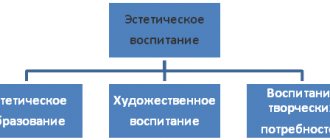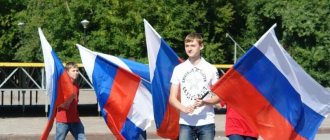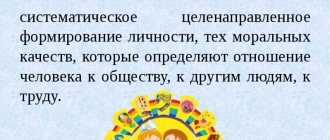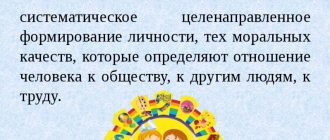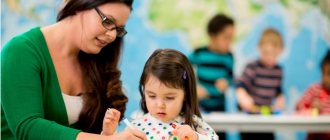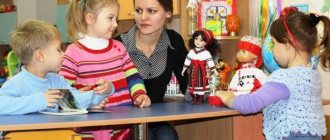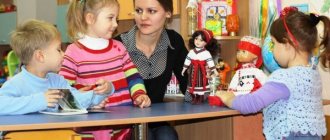The concept and essence of aesthetic education of preschool children
Definition 1
Aesthetic education is a purposeful process of influencing the personality of a preschool child, with the goal of developing his ability to see beauty in the world around him, works of art, as well as the ability to create beauty on his own.
Note 1
Aesthetic education of children must begin from the very first days of life.
Aesthetic education is a purposeful process of developing creative activity in preschool children, the ability to perceive and appreciate beauty in nature, life and art. Aesthetic education of preschool children includes instilling in children an aesthetic attitude towards social life, work, nature, art and everyday life. However, knowledge of works of art is very multifaceted, so it stands out as a separate part of the aesthetic education of children.
Are you an expert in this subject area? We invite you to become the author of the Directory Working Conditions
In the process of aesthetic education, preschool children become acquainted with the beauty in the surrounding life, nature and art, they learn to perceive and feel this beauty. This process contributes to the development of their imagination and imagination.
The system of aesthetic education for preschool children includes:
- education through artistic means;
- education through art;
- education through extra-artistic means (nature, work, environment, educational activities, etc.).
Note 2
Thus, the process of aesthetic education includes general cultural, philosophical and psychological-pedagogical education.
The purpose and objectives of aesthetic education of preschool children
The main goal of aesthetic education of preschool children is to give children the necessary knowledge, skills and abilities from various fields of art, as well as to develop their interest and desire to engage in independent creative activities.
Finished works on a similar topic
Course work Aesthetic education of preschool children 430 ₽ Abstract Aesthetic education of preschool children 240 ₽ Test work Aesthetic education of preschool children 220 ₽
Receive completed work or specialist advice on your educational project Find out the cost
Achieving the main goal of aesthetic education of preschool children is achieved through the consistent solution of a number of the following groups of tasks:
- The first group of tasks of aesthetic education are tasks aimed at developing in children an aesthetic attitude towards the world around them and their acquisition of theoretical knowledge. Includes a number of the following tasks:
- education of aesthetic culture in children;
the formation and development of aesthetic perceptions, feelings and experiences, as well as an aesthetic attitude towards the activities surrounding the child;
- developing in children the ability to see and feel beauty in actions, nature, art, and the world around them;
- cultivate the need for knowledge of beauty;
- nurturing the desire to surround yourself with beauty, to create it with your own hands.
- The second group of tasks of aesthetic education of preschool children is the formation in children of practical skills in the field of various types of arts. Includes:
- teaching children to sculpt, draw, design, sing, and move to music;
formation and development of oral creativity.
Aesthetic education of preschool children within the preschool educational institution involves solving the following problems:
- Carrying out the systematic development of the perception of beauty and aesthetic feelings of children, through various types of arts, activities, emotional involvement, etc.
- Introducing children to art, teaching them practical skills, educating them to bring elements of beauty into the environment as much as possible.
- Formation in children of aesthetic taste and the ability to independently evaluate works of art and life phenomena.
- Development of children's creative and artistic abilities through the organization of activities related to art.
Artistic and aesthetic education in preschool educational institutions
Topic of the article: “Organization of work on the artistic and aesthetic development of preschool children.”
Head of the Children's Preschool Educational Institution "Nursery-Garden No. 273 in Donetsk"
V.V. Poryvaeva
At this time, attention has increased to the problems of the theory and practice of artistic and aesthetic development as the most important means of forming an attitude towards reality, a means of moral and mental education, that is, as a means of forming a comprehensively developed, spiritually rich personality.
Along with physical, mental and moral development, artistic and aesthetic development occupies a significant place in the work of a preschool institution. Preschool teachers pay great attention to various aspects of aesthetic development - the design of the room and area, the appearance of children and adults, the use of works of art. Among the activities conducted with children, a considerable share belongs to classes in which children draw, sculpt, listen to fiction, learn to read expressively, sing and dance to music. Aesthetic development is carried out under the influence of reality (nature, everyday life, work and social life) and art (music, literature, theater, works of artistic and decorative creativity). The forms of organizing children's aesthetic activities are varied. These are games, activities, excursions, holidays, entertainment. It is very important that the teacher’s work in this direction is built on a scientific basis and carried out according to a specific program that takes into account the current level of development of various types of art, in compliance with the principle of gradualism, consistent complication of requirements, and a differentiated approach to the knowledge and skills of children of different ages.
The aesthetic life of a child is remarkable for its universalism - and this is what makes it most different from the aesthetic life of adults: everything beautiful, whatever its form, attracts and captivates children. Children love music, fairy tales, drawing, modeling, dancing, and stage performances. Another characteristic feature of children's aesthetic life is its creative nature: a child can never limit himself to aesthetic perception, he invariably strives for creativity, using all the means available to him.
That is why we pay great attention to the artistic and aesthetic development of our students.
The system of artistic and aesthetic development of preschool children will be successful if the following pedagogical conditions are implemented:
- creating an environment of emotional well-being;
- creation and updating of a subject-development environment;
- creative approach to the content of education;
- variability in the choice of lesson topics, forms, means, methods of working with children, and materials provided;
- using a student-centered approach in teaching children;
- synthesis of classes in drawing, modeling, appliqué with classes to familiarize children with nature;
- use of musical works in visual arts classes;
- implementation of a regional approach to the selection of the content of visual, musical, gaming and other artistic activities (systematic familiarization of children with the art historical material of artists, poets, composers describing nature, work, life);
- interaction with families of pupils;
- continuity in work with cultural institutions.
Work on artistic and aesthetic education is part of a holistic educational process and includes all participants: teachers, children, parents.
When working with teachers, you must be guided by the following principles:
— individual approach;
— practical activity approach;
- systems approach.
The listed principles synthesize all aesthetic concepts around themselves, revealing, justifying and developing them. They substantiate the aesthetic view of the world, which predetermines the content of aesthetic education, which includes two components: the content of educational activities to develop the artistic activity of children; the content of educational influences on the artistic and aesthetic development of pupils in the process of educational activities of all kindergarten employees and the family as a whole.
Methods of artistic and aesthetic education of preschool children:
1. Methods for the formation of aesthetic consciousness
-
this includes methods of inducing empathy (empathy forms an emotionally positive attitude towards the positive, beautiful in life and art, and a negative attitude towards the negative), the method of forming emotional responsiveness to the beautiful, the method of persuasion.
2. Methods of organizing artistic activities
– these include the method of training, exercises in practical actions aimed at introducing an aesthetic element into everyday life and behavior: these methods are aimed at developing aesthetic perception, aesthetic taste and are intended to transform the environment and develop skills of a culture of behavior in a growing child.
3. Methods of stimulating and activating artistic creativity
-
these usually include the method of search situations, creative tasks, methods of encouraging children to be creative: in this regard, the method of encouraging students to be creative implies teacher-directed creativity of children, the creation of situations for it. This method is a mechanism for children's development. In turn, problem situations are means of activating this mechanism and encourage children to take creative and practical action on the task at hand.
The above methods acquire specificity in relation to the type of children's activity that is modeled by adults in the process of artistic and aesthetic education.
The implementation of the artistic and aesthetic development of students is facilitated by the following forms of systematic work with teaching staff:
- consultations,
- viewing and discussion of video materials,
- joint gaming and educational activities,
- seminars, seminars - workshops,
- teacher councils,
- business games,
- shows,
- competitions,
- creative weeks,
- master classes,
- surveying teachers on problems in this area,
- creative portfolio,
- methodological associations for the artistic and aesthetic development of children;
- presentation of the experience of preschool teachers at city seminars and competitions.
Means of content implementation
artistic and aesthetic development was selected in accordance with the goals and objectives set for the preschool educational institution:
- aesthetic communication
- a special condition and means of aesthetic education, aimed at getting children interested, igniting their hearts, developing activity in them, awakening in every child faith in his creative abilities, in the fact that he came into the world to create goodness and beauty, to bring people joy;
- nature:
it contains a variety of sensory and aesthetic properties and thanks to this, it has enormous opportunities for children to understand, according to L. Leonov, the richness of the world in which they live, a world that is friendly to people, in addition, nature helps children opened up to him with all our souls;
- art
(music, literature, theater, works of artistic and decorative creativity) contributes to the formation of sense organs designed to perceive certain types of art, forms aesthetic taste, allows you to adjust your aesthetic ideal, correlate the value guidelines of different eras and peoples;
- surrounding subject environment,
according to K. A. Flerina, it increases the activity, creative nature of artistic and aesthetic activity of preschoolers, and its effectiveness. She pointed out that not only beautiful objects in themselves educate children aesthetically, “but also that lively work, that caring attitude of the teacher and children to the things that need to be educated”;
- independent artistic activity
children (musical, visual, artistic and gaming) is a means and process of developing in children the ability to feel, understand and love art, developing the need for artistic and creative activity, forming a child’s worldview through the means of art;
- various types of games
: didactic, active, role-playing, dramatization games, etc.;
- different types of child labor
in kindergarten, the significance of which was spoken by V. A. Sukhomlinsky: he connected them with the formation of ideas about the beauty of being and the joy of its creation: “The joy of work is the beauty of being”;
- physical exercises and elements of sports games.
To successfully implement the priority for artistic and aesthetic development, work at the preschool educational institution is built in the following areas
:
- Creating working conditions for the artistic and aesthetic development of children
- Working with teaching staff
- Working with kindergarten students
- Interaction with parents (legal representatives)
Let's consider working with teaching staff
Directions of work of the manager:
— familiarizing the team with existing programs and methods of artistic and aesthetic education;
— choice of program and methodology (together with the teaching staff);
— determining the place of artistic and aesthetic education in the general educational space of the kindergarten, its connection with other areas;
— control over the coordination of the work of all specialists and educators; implementation of an integrated approach;
— monitoring the activities of the entire team;
— participation in the preparation of diagnostic cards, in the diagnosis of children and analysis of its results;
— conducting methodological seminars for team members;
— participation in improving the developmental subject environment;
— participation in disseminating the experience of preschool educational institutions;
— presence in classes in order to determine the behavioral characteristics and characteristics of preschoolers (voluntariness, comfort, etc.);
— work with parents to fulfill the goals and objectives of artistic and aesthetic education;
— coordination of work with other institutions (school, museum, music school, library, art school);
— generalization of the results of the work.
Result of the work:
-The theoretical and practical level of teachers’ knowledge has increased;
-Teachers are actively introducing new technologies, developing classes, leisure scenarios, themed evenings;
-We take part in exhibitions of children's creativity, competitions of children's works;
-We take an active part in dramatization and staging competitions;
-Preschool students maintain an interest in music and choreography by attending music school and dance studios.
We don't stop there. The active position and creative potential of teachers convince us of the correctness of the chosen path. Participation and achievements in events at the district and city level inspire new successes. We plan to expand the circle of interaction, taking into account the requests of parents, the interests of students and social partners, and we continue to look for new ways of cooperation with parents. After all, we have one goal - to educate future creators of life. What a person is like is the world he creates around himself. I would like to believe that our children, when they grow up, will love and protect their loved ones.
Used Books
- Alabastrova, A.A. Directory of the head of a preschool educational institution /. – M.: VAKO, 2008. – 208 p.
- Anshukova, E.Yu. Analytical activity of a senior teacher. // Management of preschool educational institutions. - 2004. No. 3.- P. 15-19.
- Belaya, K.Yu. Methodological work in preschool educational institutions: Analysis, planning, forms and methods / K.Yu. Belaya. — M.: Sfera, 2005
- Belaya, K.Yu. From September to September. Recommendations to the head and senior teachers of a kindergarten for planning educational work / K.Yu. Belaya. – M.: AST, 1998
- Bondarenko, A.K. Head of preschool: A manual for heads of preschools / A.K. Bondarenko, L.V. Pozdnyak, V.I. Shkatulla. – M.: Education, 1984. – 223 p.
- Vasilyeva, A.I. Senior kindergarten teacher / A.I. Vasilyeva, L.A. Bakhturina, I.I. Kobitina. – M., 1990
- Vasilyeva, A.I. Kindergarten teacher-methodologist / A.I. Vasilyeva, L.A. Bakhturina, I.I. Kobitina. – Minsk, 1975
- Vinogradova, N.A. Quality management of the educational process in preschool educational institutions: methodological manual / N.A. Vinogradova, N.V. Miklyaeva. – 2nd ed. – M.: Iris-press, 2007. – 192 p.
- Dubrova, V.P. Organization of methodological work in educational institutions / V.P. Dubrova, E.P. Milashevich. – M., 1995. – 128 p.
- Izergina, K.P. Our “adult” kindergarten / K.P.Izergina, L.S.Presnyakova, T.V.Inshakova. - M.: Education, 1991
- Kalmykova, V.A. Management of public preschool education in the region / V.A. Kalmykova. - M.: Education, 1988
- Kovalev, A.G. Team and socio-psychological problems of management / A.G. Kovalev. - M., 1978
